Interesting Facts About Floods You Never Knew
You might be surprised to learn that floods are more dangerous than you think. Did you know that just six inches of fast-moving water can knock you off your feet? Or that 66% of flood-related deaths occur when drivers get trapped in deep water? Floods aren't just about water damage; they carry hidden hazards like debris, chemicals, and live wires. Notably, 40% of flood insurance claims come from low-risk zones, challenging the assumption that only high-risk areas flood. Climate change has increased coastal flooding by 900% in the last 50 years, making flood awareness vital. These facts only scratch the surface of this complex natural disaster.
This post may contain affiliate links. If you make a purchase through these links, I may earn a commission at no additional cost to you. Additionally, portions of this post may be generated using artificial intelligence (AI) technology. While we strive for accuracy, please be aware that AI-generated content may not always be perfect and should be fact-checked when necessary.
The Spatula Scoops
- Floods account for 90% of all natural disasters globally and have affected over 2 billion people in the last 30 years.
- Six inches of fast-moving floodwater can knock a person off their feet, while one foot can sweep away a small car.
- Wetlands can absorb up to 330,000 gallons of water per acre, saving the U.S. over $30 billion annually in flood repair costs.
- 40% of flood insurance claims come from low-risk flood zones, challenging assumptions about flood-prone areas.
- Climate change has caused a 900% surge in coastal flooding occurrences over the last 50 years.
The Global Impact of Floods

When you think about natural disasters, floods might not be the first thing that comes to mind. However, you'd be surprised to learn that floods are actually the most common natural disaster worldwide. In fact, they account for a staggering 90% of all natural disasters globally, affecting over 2 billion people in just the past three decades.
The impact of floods goes far beyond their frequency. You might not realize the extent of flood damage, but since 2000, the total cost of flood-related damages has surpassed $1 trillion. That's an enormous financial burden on communities and economies worldwide. Even more sobering is the human toll: flooding is responsible for half of all disaster-related deaths.
As flood risks continue to increase, it's vital to understand their global impact. Coastal flooding, for instance, has seen a 900% surge in occurrences over the last 50 years. This dramatic increase is closely linked to climate change and rising sea levels. The good news? Global coordinated approaches to flood risk reduction can be incredibly cost-effective, potentially saving up to seven times the investment made in mitigation and recovery efforts.
Hidden Dangers of Floodwaters
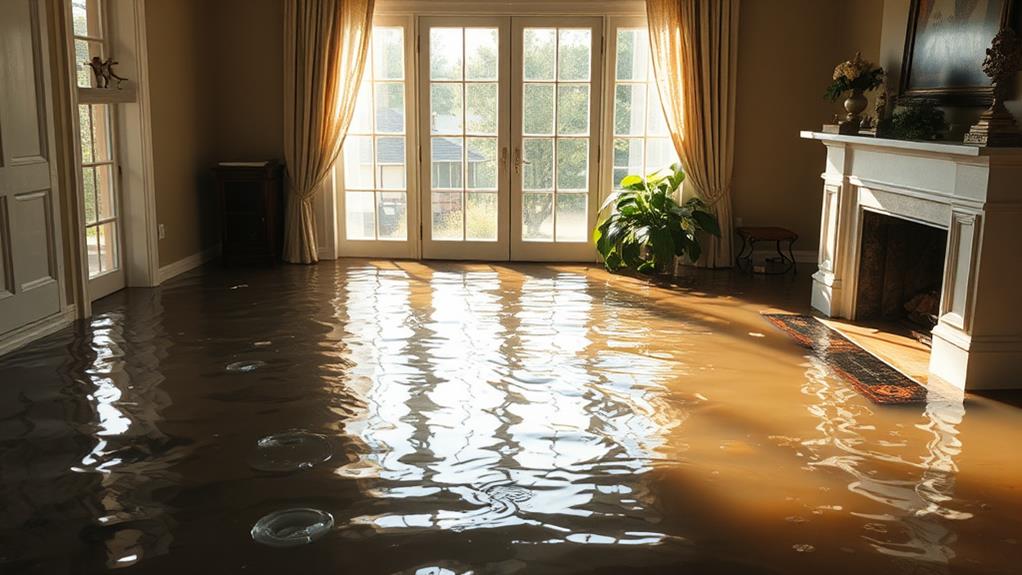
You might think floodwaters are just a nuisance, but they're hiding serious dangers you can't see. Beneath the surface lurks debris that can injure you, and the water's depth is often more treacherous than it appears. What's more, these waters are often contaminated with pollutants and pathogens, putting your health at risk if you come into contact with them.
Unseen Hazards Below Surface
Hidden beneath the murky surface, floodwaters conceal a myriad of dangers that often go unnoticed. When you're faced with flood waters, you're not just dealing with water; you're potentially encountering a hazardous cocktail of debris, chemicals, and live electrical wires. These hidden risks can cause severe injuries or worse if you attempt to wade through or drive into flooded areas.
You might be surprised to learn that just six inches of fast-moving water can knock you off your feet, while a mere foot of water can sweep away a small car. This illustrates the deceptive power of floods, which often appears less threatening than it truly is. The depth and current of floodwaters can be misleading, hiding treacherous conditions beneath a seemingly calm surface.
It's essential to understand that approximately 66% of flood-related deaths occur when drivers become trapped in deep water. This statistic highlights the importance of avoiding flooded roads at all costs. Even if the water looks shallow, you can't see what's lurking below or gauge the strength of the current. Your safety depends on respecting the unseen hazards of floodwaters.
Deceptive Water Depth
Appearances can be deceiving when it comes to floodwaters. You might think that shallow-looking water is safe to traverse, but this misconception can lead to dangerous situations. Just six inches of fast-moving water can knock you off your feet, highlighting the hidden risks of flood conditions. Even if the water seems calm, it may conceal hazardous debris that can cause injury or damage.
The deceptive nature of water depth during floods is a significant risk factor. While a small vehicle might handle 12 inches of water, doubling that depth to 24 inches can sweep most cars away. This illustrates why it's vital not to underestimate the power of floodwaters. Shockingly, about 66% of flood-related deaths involve drivers attempting to navigate through deep water. You might think you can judge the depth accurately, but floodwaters are notoriously misleading. Many people overestimate their ability to safely cross flooded areas, putting themselves in peril. Remember, it's always better to err on the side of caution when faced with flood conditions. The potential for damage and loss of life far outweighs any perceived convenience of trying to push through floodwaters.
Contamination and Disease
Long after floodwaters recede, the hidden dangers of contamination and disease can linger. You might think the worst is over, but contaminated floodwater can pose serious health risks. Floodwaters often carry a toxic mix of sewage, chemicals, and debris that can lead to various health issues.
Disease outbreaks are common in flood-affected areas due to water contamination. You're at risk of contracting illnesses like leptospirosis and gastrointestinal infections if you're exposed to these waters. Even wading through floodwaters can be dangerous, as you might sustain injuries from hidden debris, potentially leading to infections.
To protect yourself and your community, it's important to:
- Avoid direct contact with floodwater whenever possible
- Use proper protective gear if you must enter contaminated areas
- Follow all public health safety guidelines and advisories
Environmental pollution is another significant concern. Contaminated floodwater can have far-reaching effects on local ecosystems and drinking water supplies. That's why proper sanitation measures and thorough water testing are vital after flooding events. These steps help prevent disease transmission and guarantee the safety of your community's water sources.
Surprising Flood Insurance Facts
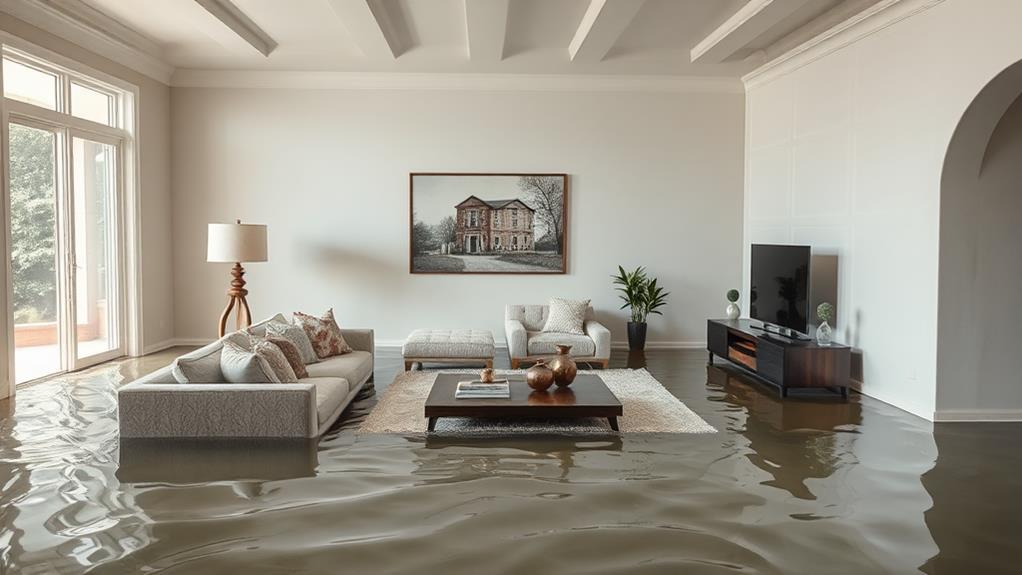
Did you know that your standard homeowners insurance doesn't cover flood damage? If you live in a flood-prone area, you'll need a separate Flood Policy to protect your home and belongings. Surprisingly, around 40% of flood insurance claims come from policyholders in low-risk flood zones. This statistic highlights the importance of coverage, regardless of your perceived risk.
If you're considering flood insurance, don't wait until the last minute. Most federally backed National Flood Insurance Program (NFIP) policies have a 30-day waiting period before they become active. This means you should secure coverage well in advance of any potential flood threats.
The financial impact of flooding is significant. From 2005 to 2014, average annual flood insurance claims exceeded $3.5 billion. If you're a homeowner in a designated flood zone, you face a 1 in 4 chance of experiencing flooding over a 30-year period. These statistics underscore the critical importance of flood insurance for long-term financial protection. Remember, being prepared can save you from devastating losses in the event of a flood.
Urban Development and Flood Risks
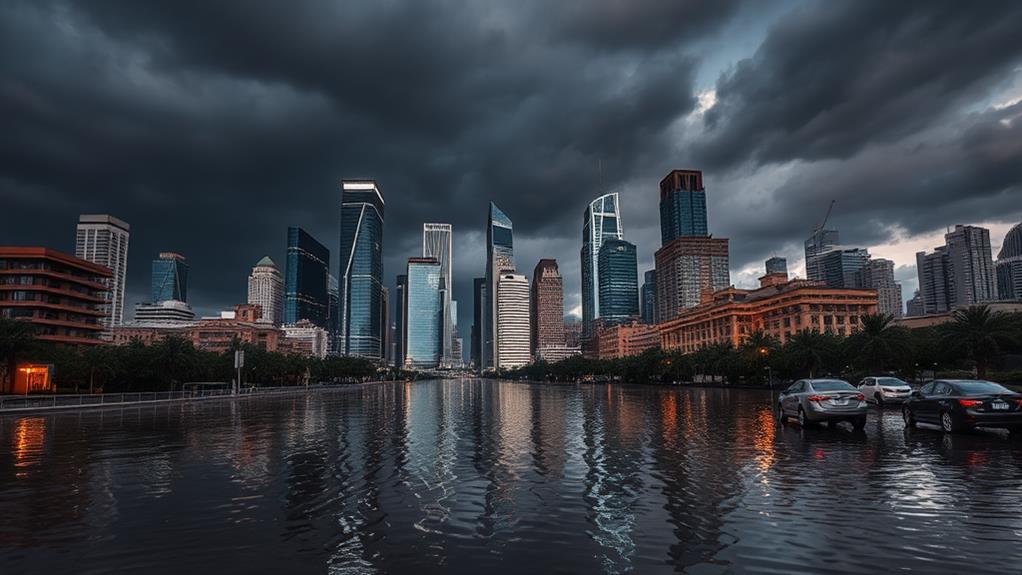
You might be surprised to learn how urban development can increase your flood risk. As cities grow, natural runoff patterns are altered, and the increase in impervious surfaces like roads and buildings prevents water from being absorbed into the ground. This combination of factors can overwhelm existing drainage systems, leading to more frequent and intense flooding in areas that may not have experienced such issues before.
Altered Runoff Patterns
Urban development can be a double-edged sword when it comes to flood risks. While it brings progress, it can also greatly alter natural runoff patterns, increasing flood risk in areas that were previously safe. You might be surprised to learn that about 17% of U.S. urban land is located in high-risk flood zones, highlighting the importance of careful urban planning.
When land development occurs, it often outweighs existing flood management measures. This means that newly constructed neighborhoods may face elevated chances of flooding. The reason? Increased impervious surfaces like roads and buildings change how water flows across the landscape. As a result, areas with altered runoff can experience flooding events more frequently.
If you're living in or considering moving to an area prone to flooding due to altered runoff patterns, it's essential to:
- Stay informed about local flood risks
- Engage in proactive discussions with builders and neighbors
- Consider flood insurance options
Increased Impervious Surfaces
Concrete jungles aren't just a metaphor when it comes to flood risks. Urban development has dramatically altered our landscapes, increasing impervious surfaces like asphalt and concrete. You might not realize it, but these surfaces play a significant role in exacerbating flood risks in urban areas.
When rain falls on natural surfaces, much of it is absorbed into the ground. However, impervious surfaces prevent this natural absorption, causing water to run off rapidly. This altered runoff pattern can lead to flooding in areas that previously didn't experience such issues. In fact, over 20% of flood insurance claims come from low-risk areas, often due to recent land development.
The problem is compounded by the fact that heavy rainfall events have increased by 20% over the last five decades. With urban areas containing high levels of imperviousness accounting for about 17% of urban land in high-risk flood zones, it's clear that effective planning and mitigation strategies are essential. As you consider urban development in your area, remember that these impervious surfaces aren't just changing the landscape – they're reshaping our flood risks too.
Overwhelmed Drainage Systems
As cities expand and impervious surfaces multiply, drainage systems often struggle to keep pace. You might be surprised to learn that urban development greatly alters natural runoff patterns, increasing the risk of flooding in areas previously evaluated as safe. In fact, about 17% of U.S. urban land is located in high-risk flood zones, highlighting the vulnerability of developed areas.
When drainage systems become overwhelmed, the consequences can be severe. Here's what you need to know:
- Urbanization changes natural drainage systems, exacerbating flooding risks during heavy rainfalls.
- Land development can overwhelm existing flood management measures.
- Over 20% of flood insurance claims come from areas outside designated floodplains.
These facts underscore the unpredictability of flood risks in urban settings. You might think you're safe if you're not in a designated floodplain, but that's not always the case. Overwhelmed drainage systems can lead to increased flooding incidents even in low-risk areas. As a result, it's essential to take into account flood insurance regardless of your location, as urban development continues to reshape our landscapes and alter flood patterns.
Wetlands: Nature's Flood Defense
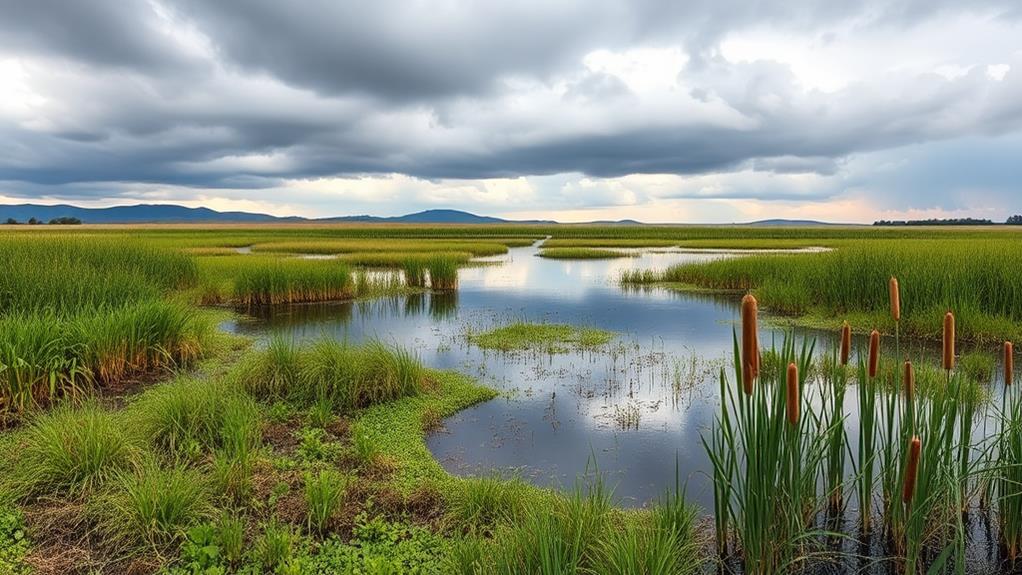
Nature's flood defense system lies hidden in plain sight: wetlands. These remarkable ecosystems play an essential role in flood management, acting as natural sponges that absorb excess water during heavy rainfall or storm surges. You might be surprised to learn that wetlands can retain an impressive 330,000 gallons of water per acre, enough to supply 13 homes during flood events.
Wetlands don't just protect against floods; they're also hotspots of biodiversity. They provide critical habitats for diverse wildlife, supporting a wide range of plant and animal species. But their flood-mitigating abilities are where they truly shine. By absorbing floodwaters, wetlands substantially reduce the impact of flooding on surrounding areas, saving the U.S. over $30 billion annually in flood repair costs.
The benefits of wetlands extend beyond flood protection. They improve water quality in surrounding areas and offer essential ecosystem services that support local communities and economies. That's why restoration and conservation of wetlands are vital. By preserving these natural flood defenses, you're not only protecting your community from potential flood damage but also safeguarding invaluable ecosystems for future generations.
Climate Change and Flooding Trends
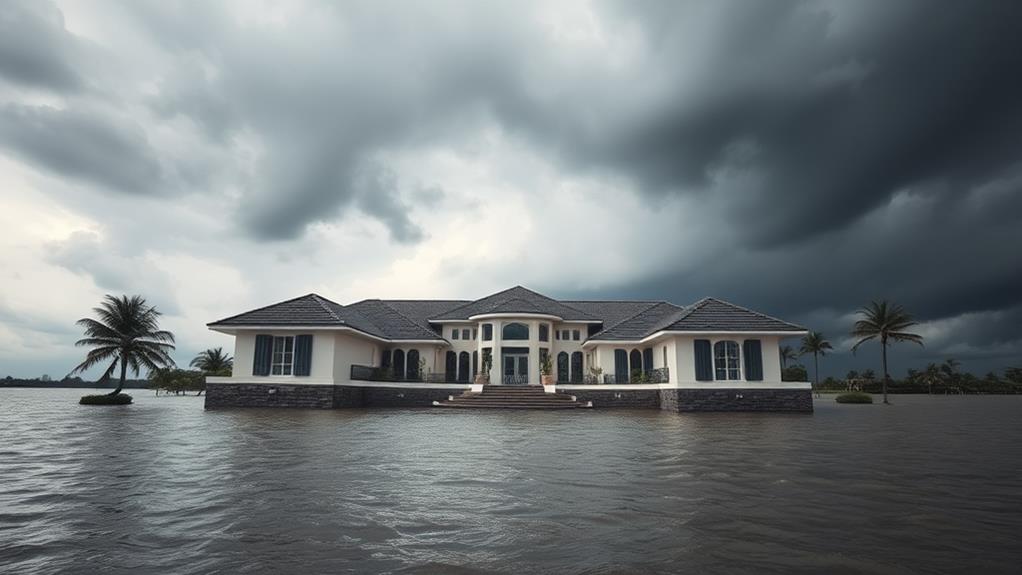
How does climate change affect flooding patterns? You might be surprised to learn that climate change has notably increased flood risks across the globe. Over the past 50 years, there's been a 20% rise in heavy rainfall events, leading to more frequent and severe flooding. This trend is expected to continue, with projections indicating a 40-45% expansion of floodplains within the next 90 years.
Climate change impacts flooding in several ways:
- Increased rainfall intensity
- Rising sea levels
- Altered weather patterns
You're probably aware that urban areas are particularly vulnerable to flooding. As cities expand, natural runoff patterns are disrupted, exacerbating the problem. But did you know that coastal flooding has increased by a staggering 900% in the last five decades? Rising sea levels are the culprit here, amplifying the effects of storm surges and high tides.
The global impact of climate change on flood risks is hard to ignore. In just three decades, over 2 billion people have been affected by floods. This statistic underscores the urgent need for adaptation strategies and mitigation efforts to address the growing threat of flooding in our changing climate.
Flood Myths Debunked
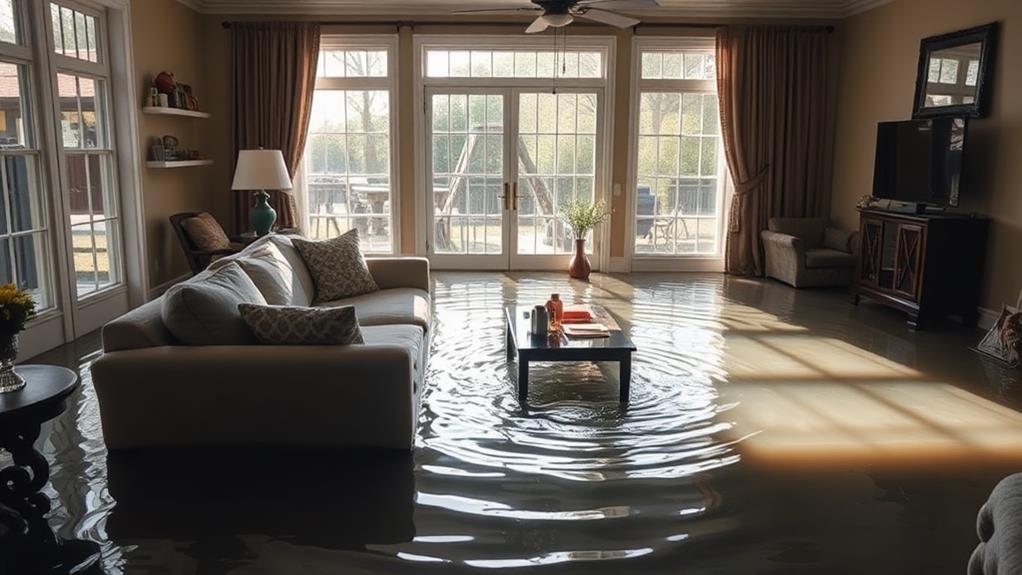
Despite widespread beliefs about flooding, many common myths can leave you vulnerable to unexpected water damage. Let's debunk some of these flood myths:
| Myth | Reality | Implications |
|---|---|---|
| Only high-risk areas flood | 25% of NFIP claims from low-risk areas | Flooding can occur anywhere |
| Standard homeowners insurance covers floods | Flood damage usually excluded | Separate flood insurance needed |
| No past flooding means no future risk | 1 in 4 chance of flooding in 30 years | Climate change increases risk |
| Flood insurance only for high-risk zones | Most disaster assistance in non-high-risk areas | Essential for all homeowners |
| Rain is the main cause of flooding | Snowmelt and hurricanes also significant | Various triggers for flooding |
You might think you're safe from floods if you're not in a designated flood zone, but over a quarter of National Flood Insurance Program claims come from low-risk areas. Don't assume your standard homeowners insurance will cover flood damage; it's usually excluded, requiring separate coverage. Even if you've never experienced flooding before, changing climate patterns mean you could face a significant risk in the future. Remember, flood insurance isn't just for high-risk areas – most disaster assistance goes to non-high-risk zones. Finally, while rain is a common cause, snowmelt and hurricanes can also trigger devastating floods.
Economic Toll of Flooding
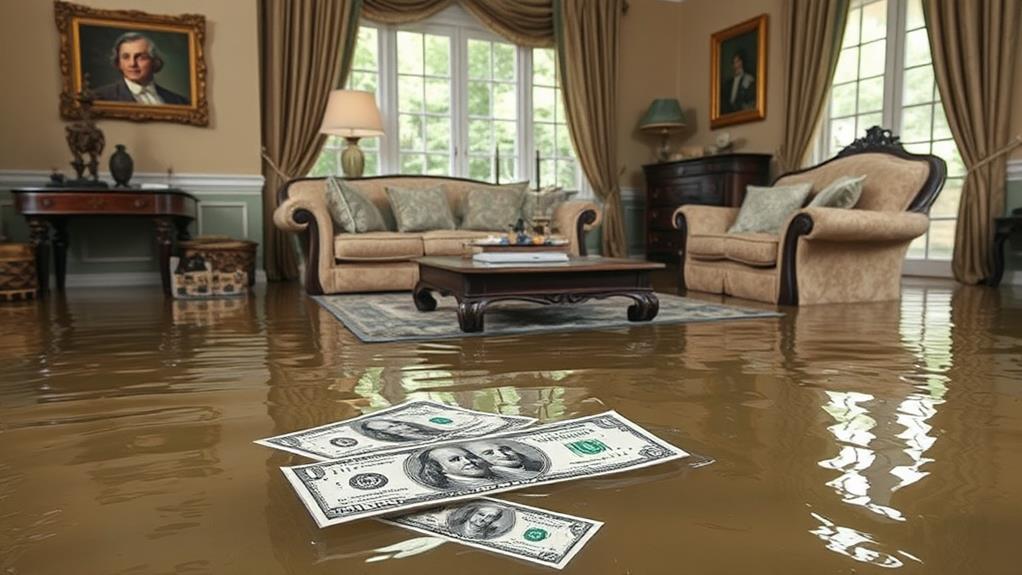
Flooding frequently exacts a staggering economic toll on communities worldwide. You might be surprised to learn that annual flood losses have jumped from $6 billion in the early 2000s to a whopping $10 billion today. That's a significant increase in just two decades. Even a seemingly minor flood can wreak havoc on your finances. Did you know that just one inch of floodwater can cause about $25,000 worth of damage to the average home?
The economic impact of flooding extends far beyond property damage. Here are three key ways floods affect the economy:
- Long-term financial downturns in local economies
- Increased insurance costs for property owners in flood-prone areas
- Billions spent on flood control measures
Despite these efforts, flood losses continue to rise, highlighting the urgent need for improved disaster preparedness and infrastructure investments. Since 2000, global flood damages have surpassed $1 trillion, underscoring the critical importance of developing coordinated flood risk reduction strategies. As climate change intensifies, addressing this growing economic toll becomes increasingly essential for communities worldwide.
Innovative Flood Prevention Technologies

As we grapple with the escalating economic impact of floods, innovative technologies are emerging to combat this growing threat. You'll be amazed at the cutting-edge flood prevention solutions being developed. Green infrastructure, like permeable pavements and rain gardens, is absorbing excess water and reducing runoff. Smart sensors and monitoring systems are providing real-time data on water levels, enhancing early warning systems.
Floating infrastructure is adapting to rising water levels in coastal cities, while flood barriers are becoming more dynamic with adjustable heights. Advanced predictive modeling tools, using big data analytics and machine learning, are improving flood risk assessments. These technologies are revolutionizing how we prepare for and manage floods.
Here's a quick overview of some innovative flood prevention technologies:
| Technology | Function | Benefit |
|---|---|---|
| Green Infrastructure | Absorbs excess water | Reduces runoff |
| Smart Sensors | Monitor water levels | Enhance early warnings |
| Floating Structures | Adapt to water levels | Protect coastal areas |
| Advanced Modeling | Assess flood risks | Improve preparation |
Frequently Asked Questions
What Are 5 Interesting Facts About Floods?
Did you know that floods are the most common natural disaster in the U.S., affecting 99% of counties since 1996? Here are five interesting facts about floods:
- Annually, about 140 Americans die in flood-related incidents.
- The "100-year flood" is misunderstood; it's a 1 in 4 chance in 30 years.
- Wetlands save over $30 billion yearly by absorbing excess water.
- Average annual flood losses have increased to $10 billion.
- Floods often catch drivers off guard in deep water.
What Is a Fun Fact About Flood for Kids?
Did you know that just six inches of fast-moving water can knock you off your feet? That's right! Even shallow floods can be super dangerous. It's like trying to stand up in a swimming pool with a strong current. This fun fact shows why it's important to stay safe during floods. Remember, water is powerful, and even if it doesn't look deep, it can still be risky. Always listen to adults and follow safety guidelines during flood warnings.
What Are Some Historical Facts About Floods?
You've likely heard of Noah's Ark, but floods have shaped history far beyond biblical tales. In 1927, the Great Mississippi Flood displaced over 600,000 people and caused $1 billion in damages. China's 1931 Yangtze River flood was even more catastrophic, claiming up to 4 million lives. The 1936 northeastern U.S. flood led to the creation of the Appalachian Regional Commission. In 1889, the Johnstown Flood killed over 2,200 Americans, while Pakistan's 2010 floods affected 20 million people, causing $43 billion in losses.
What Are 3 Largest Occurrences of Floods?
You'll find that the three largest occurrences of floods in recorded history are:
- The Great Flood of 1931 in China, which claimed 1-4 million lives and displaced over 15 million people along the Yangtze River.
- The 1970 Banqiao Dam failure in China, resulting in around 240,000 deaths and affecting millions.
- The 2010 Pakistan floods, impacting 20 million people, causing 2,000 deaths, and resulting in damages exceeding $10 billion.
These events demonstrate the devastating power of floods on human populations and infrastructure.





